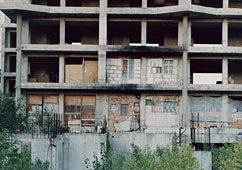















































| Persepolis | ||
 |
 |
 |
 |
 |
 |
 |
 |
 |
 |
 |
 |
 |
 |
 |
 |
 |
 |
 |
 |
 |
 |
 |
|
 |
 |
 |
 |
 |
 |
 |
 |
|
 |
 |
 |
 |
 |
 |
 |
 |
 |
 |
 |
 |
 |
 |
 |
 |
 |
|
| series of photographs, 1999 - 2006 |
|
"Persepolis explores post-socialist dwelling, starting from the realization
that "Bucharest contains superimposed patterns of constructed utopia".
If I may be forgiven the pedantic nuisance of a Greek etymology, persepolis
was one of Athena's attributes, meaning "she who destroys cities".
More or less overtly, the memory of ravage is always there in the photographs,
as are the residues of ideology and unrestrained political power. Read
diachronically, the images show the painful co-existence of three historical
strata: early modernism, the particular brand of modernism practiced during
communist times, and the contorted ways of new, post-revolutionary architecture.
The flotsam of early modernism is what the severe interventions of communist
urbanism left behind, as they sought to remap Bucharest by displacement
and disruption, producing grids and gridlocks and paralyzing the organic
growth of the city. Persepolis includes both the ceremonial and the social
type of communist architecture, the first designed to express absolute
power and a complete disregard to notions of utility and scale, and the
second to replicate endlessly the same precarious suburb, lending itself
reluctantly to dwelling and discouraging the establishment of communities.
In its turn, the socialist layer sustains today the onslaught of entrepreneurial
urban thinking, engulfing and building upon urban dysfunction, adaptable
and indifferent to context, channeling peripheral energies of opposition
and colonizing space indiscriminately. Old and new ruins are striving
to mute each other in cacophonic agglomeration: read synchronically, the
images introduce viewers to an architectural war front, a site of collisions
or tense juxtapositions between disjointed urban fragments, taking bricolage
to the level of state policy and defying the prospect of a restorative
master plan.
|